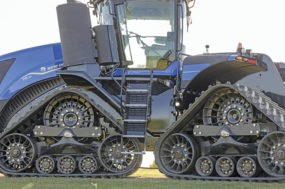Soil compaction is a year round issue, but management during high moisture conditions is even more critical to reducing compaction in agricultural fields.
A healthy soil for crop growth is dependent on proper air and water movement in the soil. When soil is compressed, the void space between the soil particles is decreased. This reduces both water and oxygen movement through the soil and can have a significant effect on proper crop growth.
In addition, water doesn’t infiltrate the surface of a compacted soil as easily, which results in increased runoff. The consequences are increased loss of nutrients and increased drought stress during dry periods because more water is running off of the soil surface.
Compacted soil also remains colder longer, thus delaying planting and germination. One final problem is root development in compacted soils, as roots will grow sideways instead of down into the soil, which reduces nutrient and water uptake by the crop.
Ground pressure on soil imposed by tracks or wheels is the primary cause of compaction. Most of the soil compaction occurs during the first pass of equipment over a loose soil. Heavy equipment driven on wet soils increases the risk for soil compaction.
Soils with higher clay contents are more prone to compaction than sandier soils.
Some management options to reduce the risk of soil compaction are:
• Limit field operations when soils are high in moisture.
• Practice controlled traffic, by driving all field equipment in the same paths every year.
• Keep tractor tires inflated to the correct pressure, over-inflation reduces the tire footprint increasing compaction and decreasing traction.
• Add more tires, or switch to bigger tires or rubber tracks.
• Remove excess weights (ballast) that make a tractor heavier when they are not required.
• Practice continuous no-till farming.
• Plant cover crops to keep plants on the farm year-round.
• Consider improving subsurface drainage to allow the soil dry out faster, thus reducing the potential for soil compaction.
Additional information on compaction can be found at:
http://www1.agric.gov.ab.ca/$Department/deptdocs.nsf/all/agdex13331
http://www.nutra-flo.com/pdf/RT-06.pdf
http://www.extension.umn.edu/distribution/cropsystems/components/7400_01.html FG
—University of Wisconsin UW-Discovery Farms Program website








